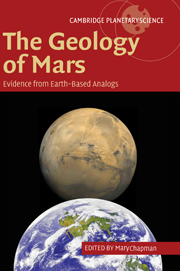Book contents
- Frontmatter
- Contents
- Preface: the rationale for planetary analog studies
- List of contributors
- 1 The geology of Mars: new insights and outstanding questions
- 2 Impact structures on Earth and Mars
- 3 Terrestrial analogs to the calderas of the Tharsis volcanoes on Mars
- 4 Volcanic features of New Mexico analogous to volcanic features on Mars
- 5 Comparison of flood lavas on Earth and Mars
- 6 Rootless volcanic cones in Iceland and on Mars
- 7 Mars interior layered deposits and terrestrial sub-ice volcanoes compared: observations and interpretations of similar geomorphic characteristics
- 8 Lava—sediment interactions on Mars: evidence and consequences
- 9 Eolian dunes and deposits in the western United States as analogs to wind-related features on Mars
- 10 Debris flows in Greenland and on Mars
- 11 Siberian rivers and Martian outflow channels: an analogy
- 12 Formation of valleys and cataclysmic flood channels on Earth and Mars
- 13 Playa environments on Earth: possible analogs for Mars
- 14 Signatures of habitats and life in Earth's high-altitude lakes: clues to Noachian aqueous environments on Mars
- 15 The Canyonlands model for planetary grabens: revised physical basis and implications
- 16 Geochemical analogs and Martian meteorites
- 17 Integrated analog mission design for planetary exploration with humans and robots
- Index
- Plate section
- References
14 - Signatures of habitats and life in Earth's high-altitude lakes: clues to Noachian aqueous environments on Mars
Published online by Cambridge University Press: 18 September 2009
- Frontmatter
- Contents
- Preface: the rationale for planetary analog studies
- List of contributors
- 1 The geology of Mars: new insights and outstanding questions
- 2 Impact structures on Earth and Mars
- 3 Terrestrial analogs to the calderas of the Tharsis volcanoes on Mars
- 4 Volcanic features of New Mexico analogous to volcanic features on Mars
- 5 Comparison of flood lavas on Earth and Mars
- 6 Rootless volcanic cones in Iceland and on Mars
- 7 Mars interior layered deposits and terrestrial sub-ice volcanoes compared: observations and interpretations of similar geomorphic characteristics
- 8 Lava—sediment interactions on Mars: evidence and consequences
- 9 Eolian dunes and deposits in the western United States as analogs to wind-related features on Mars
- 10 Debris flows in Greenland and on Mars
- 11 Siberian rivers and Martian outflow channels: an analogy
- 12 Formation of valleys and cataclysmic flood channels on Earth and Mars
- 13 Playa environments on Earth: possible analogs for Mars
- 14 Signatures of habitats and life in Earth's high-altitude lakes: clues to Noachian aqueous environments on Mars
- 15 The Canyonlands model for planetary grabens: revised physical basis and implications
- 16 Geochemical analogs and Martian meteorites
- 17 Integrated analog mission design for planetary exploration with humans and robots
- Index
- Plate section
- References
Summary
Introduction
A series of astrobiological high-altitude expeditions to the South American Andean Mountains were initiated in 2002 to explore the highest perennial lakes on Earth, including several volcanic crater lakes at or above 6000 m in elevation. During the next five years, they will provide the first integrated long-term astrobiological characterization and monitoring of lacustrine environments and their biology at such an altitude. These extreme lakes are natural laboratories that provide the field data, currently missing above 4000 m, to complete our understanding of terrestrial lakes and biota. Research is being performed on the effects of UV in low-altitude lakes and models of UV flux over time have been developed (Cockell, 2000). The lakes showing a high content of dissolved organic material (DOM) shield organisms from UV effects (McKenzie et al., 1999; Rae et al., 2000). DOM acts as a natural sunscreen by influencing water transparency, and therefore is a determinant of photic zone depth (Reche et al., 2000). In sparsely vegetated alpine areas, lakes tend to be clearer and offer less protection from UV to organisms living in the water. Transparent water, combined with high UV irradiance may maximize the penetration and effect of UV radiation as shown for organisms in alpine lakes (e.g., Vincent et al., 1984; Vinebrook and Leavitt, 1996). Shallow-water benthic communities in these lakes are particularly sensitive to UV radiation. Periphyton, which defines communities of microorganisms in bodies of water, can live on various susbtrates.
- Type
- Chapter
- Information
- The Geology of MarsEvidence from Earth-Based Analogs, pp. 349 - 370Publisher: Cambridge University PressPrint publication year: 2007
References
- 18
- Cited by



